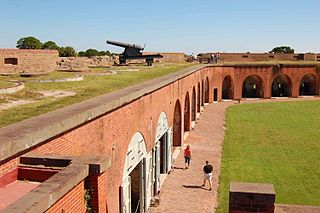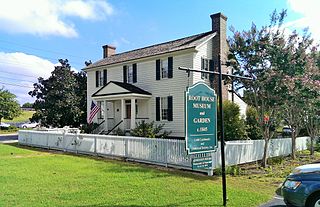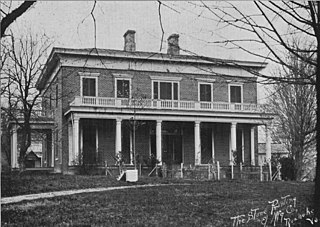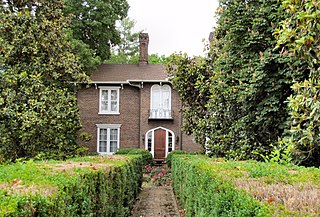
Sacaton is a census-designated place (CDP) in Pinal County, Arizona, United States. The population was 3,254 at the 2020 census. It is the capital of the Gila River Indian Community.

Putney is a town in Windham County, Vermont, United States. The population was 2,617 at the 2020 census.

Mount Jackson is a town in Shenandoah County, Virginia, United States. The population was 1,994 at the 2010 census.

Fort Pulaski National Monument is located on Cockspur Island between Savannah and Tybee Island, Georgia. It preserves Fort Pulaski, the place where the Union Army successfully tested rifled cannon in combat during the American Civil War in 1862, the success of which rendered brick fortifications obsolete. The fort was also used as a prisoner-of-war camp.

West Virginia Independence Hall is a historic government building at 1528 Market Street in downtown Wheeling, West Virginia, United States. It was built in 1860 under the supervision of architect Ammi B. Young for the federal government as a custom house, post office and courthouse. It is architecturally significant for its innovative uses of wrought iron as a framing material, and is historically significant for its role in the American Civil War. It housed the Wheeling Convention (1861), as well as the West Virginia Constitutional Convention (1863), which resulted in the separation of Unionist West Virginia from Confederate Virginia. This made it the only state to secede from a Confederate state during the war. The building was originally built as the custom house for the Western District of Virginia, and later became the center of government for the Restored Government of Virginia from 1861 to 1863, with Francis H. Pierpont serving as its governor. It was declared a National Historic Landmark in 1988. The building is now a state-run museum, housing exhibits on West Virginia history.

Edward Brickell White, also known as E. B. White, was an architect in the United States. He was known for his Gothic Revival architecture and his use of Roman and Greek designs.

The Charles Young Buffalo Soldiers National Monument, a National Monument of the United States, commemorates the life of Charles Young (1864-1922), an escaped slave who rose to become a Buffalo Soldier in the United States Army and its first African-American colonel. It is located on United States Route 42 in Wilberforce, Ohio, in a house purchased by Young in 1907 that was designated a National Historic Landmark in 1974. The monument is administered by the National Park Service; the house is open by appointment for tours.

The First White House of the Confederacy was the initial executive residence of President of the Confederate States of America Jefferson Davis and family while the capital of the Confederate States of America was in Montgomery, Alabama. Completely furnished with original period pieces from the 1850s and 1860s, the 1835 Italianate-style house is open to the public. It has been listed on the National Register of Historic Places since 1974 and the Alabama Register of Landmarks and Heritage since 2012.

The Colonel Robert A. Smith Monument, located in Hart County, Kentucky, is a monument related to the American Civil War, listed on the National Register of Historic Places. It was built in the memory of Colonel Robert A. Smith and the members of the 10th Mississippi Infantry Regiment who died in the service of the Confederate States of America on September 14, 1862, at the Battle of Munfordville.

Fort DeRussy, located south of Alexandria, Louisiana, and four miles (6 km) north of Marksville, was a Confederate earthwork stronghold during the American Civil War. It was built in 1862 to defend the lower Red River Valley in Louisiana. Located in Avoyelles Parish, the fort, cemetery and water batteries were designated as a state historic site in 1994. The fort and the water battery were listed on the National Register of Historic Places in 2016.

Idlewild is a historic plantation house and historic district just east of Talladega, Alabama, United States. The property was added to the Alabama Register of Landmarks and Heritage and the National Register of Historic Places in 1993, due to its architectural significance.

Headquarters House, also known as the Colonel Tebbetts place, is a historic house museum at 118 East Dickson Street in Fayetteville, Arkansas. Built in 1850, it saw action in the American Civil War, serving as a headquarters for both the Union and Confederacy. During the action at Fayetteville, the house was attacked by Confederate troops while serving as a Union outpost. The building was donated to the Washington County Historical Society as a museum in 1967 and was placed on the National Register of Historic Places in 1971.

The Northwest Marietta Historic District is a 230-acre (93 ha) historic district in Marietta, Georgia that was listed on the National Register of Historic Places in 1975. It includes Late Victorian, Greek Revival, Plantation Plain, and other architecture.

Whitethorne is a historic plantation house located at Blacksburg, Montgomery County, Virginia. It was built about 1855, by James Francis Preston, who received the land from his father, Governor of Virginia, James Patton Preston. It is a two-story, "L"-shaped, five bay by three bay, brick dwelling with a shallow hipped roof in the Italian Villa style. It has Greek Revival style exterior and interior decorative elements. It features a wide, elegant, one-story, five-bay front porch supported by square columns of the Tuscan order. Also on the property is a contributing two-story brick office building.

The Branner-Hicks House is a historic house in Jefferson City, Tennessee, United States.

Ewing Farm is a historic farmhouse three miles away from Lewisburg, Tennessee, US.
The Col. John Weir House is a historic house in Weir, Mississippi, U.S.

The Trousdale-Baskerville House, also known as Baskerville House and Maywood, is a historic house in Gallatin, Tennessee, U.S..
The Frobel-Knight-Borders House is a historic house in Marietta, Georgia, U.S. It was built for a Confederate veteran, and it was later the private residence of Marietta's mayor. It is listed on the National Register of Historic Places.


















